PREFACE
ICT SATELLITE ACCOUNT
Information and communication technologies (ICT) play an important role in the way in which we live and do business. There is considerable interest in the role of ICT as a significant driver of socioeconomic development, for example, in the way that ICT has allowed businesses to increase productivity. For official statisticians, the measurement of these technologies provides significant conceptual and measurement challenges. A key part of the ABS response to these challenges has been the development of an ICT satellite account for Australia for 2002-03. This was preceded by the release in 2003 of a 'pilot' ICT satellite account in respect of 1998-99.
The notion of a satellite account was conceived in the System of National Accounts 1993 to expand the core national accounts for selected areas of interest, while using relevant concepts and structures from the core national accounts. An ICT satellite account involves the identification of ICT products and activities within the national accounting framework so that a comprehensive and coherent set of economic data on ICT supply and use can be produced.
There are few international examples of ICT satellite accounts, and the concepts and methods used here are largely based on existing international statistical standards for national accounts. Nevertheless, developments from a number of international fora are also incorporated, in particular, the Organisation for Economic Co-operation and Development (OECD) Working Party on Indicators for the Information Society and the OECD Task Force on Software Measurement in the National Accounts.
This publication represents the first official satellite account on ICT and its direct contribution to the Australian economy. In particular, it contains data on the contribution of ICT to key macro-economic variables such as gross domestic product (GDP), investment, imports and exports. As this satellite account constitutes an integrated set of statistics on ICT products and services within the internationally recognised Australian System of National Accounts, it represents a valuable policy and research tool with a wide range of applications.
This satellite account is the product of development work requiring a number of assumptions and synthetic estimates for some components, and therefore at this stage the estimates should be considered experimental.
The Australian Bureau of Statistics welcomes user comments. Comments should be directed to:
Peter Comisari
Assistant Director
National Accounts Research
Australian Bureau of Statistics
Locked Bag 10
Belconnen, ACT, 2616.
INQUIRIES
For further information about these and related statistics, contact the National Information and Referral Service on 1300 135 070 or Peter Comisari on Canberra (02) 6252 5381.
INTRODUCTION
BACKGROUND TO THE ICT SATELLITE ACCOUNT
There has been substantial interest in recent years, both in Australia and internationally, in those products and services known as information and communication technology (ICT) products and services (hereafter referred to as ICT products), in the industries that import, produce or distribute those products and in who uses these products. ICT products are closely associated with the phenomenon of the 'new economy' and with other events such as the 'dotcom' boom and the privatisation of telecommunication service providers seen in a number of countries over the past two decades. Much of the demand for economic data on ICT products has been driven by the interest of economists and policy advisors in the uptake of new technologies and in the role ICT may have played in the productivity surge of the 1990s.
Satellite accounts, as articulated in the international System of National Accounts 1993 (SNA93), allow for an expansion of the national accounts for selected areas of interest while maintaining links to the basic concepts and structures of the core national accounts. The ICT satellite account developed by the ABS uses the national accounts framework to present a picture of the value of transactions in ICT products within the Australian economy. The link with the national accounts enhances the usefulness of the data in analysis because it ensures comparability to, and consistency with, key economic aggregates such as GDP. However, the satellite account does not provide an analysis of the contribution of ICT to productivity growth, nor is it a compendium of all available ICT-related information collected by the ABS or available through other sources.
The ABS provides a variety of ICT-related information from its extensive suite of ICT surveys. These surveys include the Information and Communication Technology Industries Survey (ICTIS), the Business Use of Information Technology Survey (BUIT), the Household Use of Information Technology Survey (HUIT) and the Government Technology Survey (GTS). Appendix 1 describes the framework used by the ICT satellite account in which these and other data are brought together and integrated for the whole economy.
Broadly, ICT products include computer hardware and their peripherals, parts, components and consumables, computer software, telecommunication assets, computer services, telecommunication services and wholesale and retail margins on ICT products. ICT products do not include those ICT goods and services produced and consumed in-house in the process of producing other goods and services. In turn, the 'ICT Industry' is defined with reference to those same products, and includes wholesaling and retailing. Appendix 2 provides a detailed discussion of issues relating to the scope of the ICT satellite account and the classifications used. ICT products in this publication are defined within the ABS Classification of ICT Products and are presented in Appendix 3.
The economic value of ICT products is already included in the Australian System of National Accounts (ASNA) in key economic aggregates such as GDP, industry gross value added, gross fixed capital formation (investment) and household final consumption expenditure (HFCE). However, the classifications and data sources used in the national accounts are generally not designed to systematically isolate ICT products, or the industries producing or distributing those products. Similarly, the national accounts do not systematically isolate the use of ICT products by businesses, government and households, although some important aggregates such as business investment in computer software are already separately available.
The basic compilation framework for the ICT satellite account is the national accounts 'supply and use' system. It has been adapted to focus on ICT products and the industries producing or distributing those products. Fundamentally, the system consists of a supply table that tracks the supply of ICT products from imports and from Australian producers, and a use table that tracks the use of those products by industries, government, households and for export. It aims to be comprehensive in its coverage. Many different sources of data of varying quality are used to populate the supply and use tables. Appendix 4 provides a description of the various ABS data sources used. In order to satisfy the identity that the supply and use of products must be equal, discrepancies due to deficiencies in the source data have been identified and resolved. A great strength of the framework is that it facilitates this data confrontation and provides a basis for optimising the quality of the overall estimates in the face of deficiencies and gaps in data coverage.
One role of the satellite account has been to review and, where necessary, make improvements to ICT data series used in the ASNA itself. These improvements were substantially reflected in the 'historical revision' of the national accounts published in Australian System of National Accounts 2004-05 (cat. no. 5204.0) in November 2005.
Some satellite accounts use a set of recommended classifications and frameworks developed from international research and discussion over a number of years, with international agencies usually taking the lead. For example, when the ABS developed its satellite accounts for tourism and non-profit institutions there were international guidelines available to guide the work. There are no such guidelines available for an ICT satellite account, although there have been international initiatives on some aspects important to this work.
International experience shows that the measurement of ICT transactions is not easy, particularly given the intangible nature of software, the licencing and leasing arrangements involved and the bundling of ICT products. It was therefore inevitable that a range of significant data and other issues required close attention in producing this publication. Appendix 5 provides detail on the substantial number of methodological issues encountered. Inevitably, a number of judgement calls were necessary to integrate the data and to take a stance on issues for which there is as yet no clear international standard. Consequently, the results contained in this publication should be considered experimental. Appendix 6 provides further comment on the quality of the estimates produced and Appendix 7 describes the relationship between these estimates and certain other ICT-related ABS data series.
Because of the large developmental aspect to the ICT satellite account, this publication gives considerable attention to describing the ABS response to the various challenges encountered in producing the published tables. The ABS hopes this will encourage constructive commentary on the issues described and contribute to the development of best practice in statistical measurement internationally.
This publication was preceded by a pilot ICT satellite account in respect of 1998-99, the results of which were published as a feature article 'An Information and Communication Technology Satellite Account' in the December quarter 2002 issue of Australian National Accounts: National Income, Expenditure and Product (cat. no. 5206.0). On the basis of knowledge gained from the pilot ICT satellite account, the ABS undertook to collect a range of additional data from businesses and government to compile the accounts contained in this publication.
ANALYSIS OF RESULTS
KEY RESULTS
The scope of this satellite account was determined by the range of goods and services considered to be 'ICT'. Essentially, ICT products include computer hardware, computer software, telecommunication assets, computer services and telecommunication services. An ICT satellite account details the supply and use of these products and also measures the direct value that ICT products add to the economy through the key aggregates ICT GDP and ICT gross value added.
ICT GDP represents the total market value of ICT products produced in Australia after deducting the cost of goods and services used up in the process of production. ICT accounted for $36.2 billion or 4.6% of total GDP in 2002-03.
Industry gross value added is free of the effects of changes in taxes and subsidies on products that can vary between industries and over time and is therefore the preferred national accounts measure of industry contribution to value of production. ICT gross value added was $34.8 billion (4.9% of total gross value added) in 2002-03.
The ICT share of gross value added exceeds the ICT share of GDP. Since GDP is equivalent to gross value added plus taxes less subsidies on products, this result simply reflects ICT's relative share of taxes less subsidies on products.
ICT share of the Australian economy, 2002-03
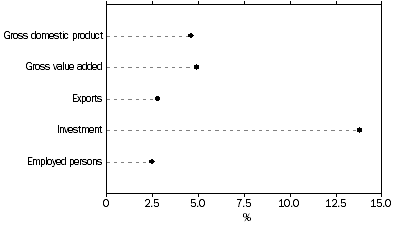
ICT GROSS VALUE ADDED
There is no 'ICT industry' in the Australian and New Zealand Standard Industrial Classification (ANZSIC). Instead, producers of ICT products operate in a number of ANZSIC industries. Of the ICT contribution to total gross value added of 4.9%, Telecommunication services contributed 2.2 percentage points, Computer services 1.4 percentage points, ICT wholesale 0.7 percentage points, ICT manufacturing 0.1 percentage points and all other industries 0.5 percentage points.
Viewed differently, the most significant industry contributors to ICT gross value added were Telecommunication services (44.3%), Computer services (28.0%) and ICT wholesale (14.8%).
INDUSTRY CONTRIBUTION TO ICT GROSS VALUE ADDED - 2002-03 |
|  |
 |  | ICT gross value added | Share of ICT gross value added |  |
 |  | $m | % |  |
|  |
| ICT specialist industries |  |  |  |
 | Manufacturing | 709 | 2.0 |  |
 | Wholesale | 5 165 | 14.8 |  |
 | Telecommunication services | 15 397 | 44.3 |  |
 | Computer services | 9 740 | 28.0 |  |
 | Total ICT specialist industries | 31 011 | 89.1 |  |
| Other industries | 3 781 | 10.9 |  |
| Total | 34 792 | 100.0 |  |
|  |
COMPARISON WITH 'NON-ICT' INDUSTRIES
When compared with the seventeen conventional ANZSIC industry divisions the ICT contribution to total gross value added of 4.9% in 2002-03 ranked ninth. ICT gross value added exceeded that of Agriculture, forestry and fishing (3.3%), Government administration and defence (4.4%), Education (4.8%), and Personal and other services (2.0%). Among the industries with a contribution to total gross value added exceeding that of ICT were Mining (5.0%), Construction (6.4%) and Finance and insurance (7.4%).
INCOME COMPONENTS OF ICT GROSS VALUE ADDED
Gross value added corresponds to the income items compensation of employees, gross operating surplus, gross mixed income and other net taxes on production. In the ICT specialist industries, compensation of employees ($17.1 billion) and gross operating surplus and gross mixed income ($13.1 billion) combined comprised 97.5% of gross value added. Among the ICT specialist industries, Computer services contributed most to compensation of employees, and Telecommunication services had the highest gross operating surplus / gross mixed income.
INCOME COMPONENTS OF ICT GROSS VALUED ADDED - 2002-03 |
|  |
 |  | Compensation of employees | Gross operating surplus/Gross mixed income | Other net taxes on production | ICT gross value added |  |
 |  | $m | $m | $m | $m |  |
|  |
| ICT specialist industries |  |  |  |  |  |
 | Manufacturing | 492 | 188 | 29 | 709 |  |
 | Wholesale trade | 3 970 | 1 024 | 171 | 5 165 |  |
 | Telecommunication services | 4 913 | 10 220 | 264 | 15 397 |  |
 | Computer services | 7 740 | 1 688 | 312 | 9 740 |  |
 | Total ICT specialist industries | 17 115 | 13 120 | 776 | 31 011 |  |
| Other industries | na | na | na | 3 781 |  |
| Total | na | na | na | 34 792 |  |
|  |
| na not available |
AUSTRALIAN PRODUCTION OF ICT PRODUCTS
The value of Australian production of ICT products was $65.1 billion in 2002-03. Over 90% of this production took place within ICT specialist industries. The largest single contributor to total Australian production of ICT products was Telecommunication services ($32.7 billion) followed by Computer services ($15.5 billion). Retail trade ($3.6 billion) was the largest contributor among the 'Other industries'.
INVESTMENT IN ICT
Business and government invested $26.7 billion in ICT products in 2002-03. Computer hardware made up 40.2% ($10.7 billion) of this investment and packaged and customised software 30.8% ($8.2 billion). The Communication services industry ($5.1 billion) contributed 19.3% to total ICT investment - the largest share of any industry. Other major industry contributors to ICT Investment were Property and business services (14.1%), Finance and insurance (12.1%), Government administration and defence (11.4%) and Manufacturing (8.6%).
Industry share of ICT investment, 2002-03
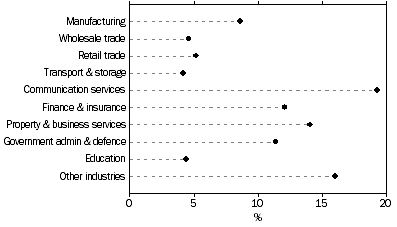
Private businesses and public corporations contributed 83.4% ($22.3 billion) of total investment in ICT products in 2002-03 while general government contributed 16.6% ($4.5 billion). The Commonwealth Government accounted for 59.5% of general government sector ICT investment. The largest ICT product investment by any sector was private sector investment in software ($9.2 billion), followed closely by private sector investment in computer hardware ($8.8 billion). General government invested $2.1 billion in software, $2.0 billion in computer hardware and $0.4 billion in telecommunication equipment.
ICT investment, By sector and product - 2002-03
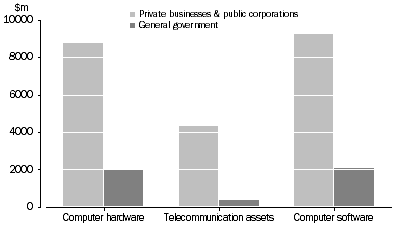
Investment in ICT accounted for 13.8% of total investment in Australia in 2002-03. Some industries invest more intensively in ICT, which is reflected in the marked industry-to-industry variation in the proportion of ICT investment to total investment. The Communication services industry had the largest proportion of ICT investment to total investment at 80.7%. This was followed by Government administration and defence (58.2%), Finance and insurance (48.2%), Wholesale trade (30.3%), and Property and business services (27.1%).
ICT investment to total investment, By selected industries - 2002-03 |
|  |
 | ICT investment as a proportion of total investment |  |
 | % |  |
|  |
| Wholesale trade | 30.3 |  |
| Communication services | 80.7 |  |
| Finance and Insurance | 48.2 |  |
| Property and business services | 27.1 |  |
| Government admisnistration and defence | 58.2 |  |
| All other industries(a) | 11.3 |  |
| Total | 13.8 |  |
|  |
| (a) Excluding ownership of dwellings and ownership transfer costs. |
Annual growth in investment for computer hardware and software fluctuated between 1997-98 and 2004-05, though it remained positive throughout this period. The 18.3% peak in growth in software investment between 1998-99 and 1999-2000 reflected Y2K related software spending.
Investment in computers, Annual growth - 1997-98 to 2004-05
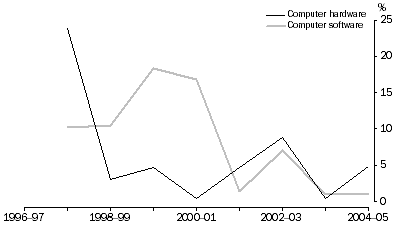
BUSINESS USE OF SELECTED ICT TECHNOLOGIES
The following table shows recent trends in business use of computers and the Internet, and web presence in businesses. Over the last five years, business use of these technologies has increased substantially, particularly business presence on the web and use of the Internet. In 2002-03, 83% of businesses indicated use of a computer, while 71% used the Internet and 23% had a web presence.
BUSINESS USE OF SELECTED TECHNOLOGIES |
|  |
 | 1997-98 | 1999-00 | 2000-01 | 2001-02 | 2002-03 |  |
 | % | % | % | % | % |  |
|  |
| Businesses using a computer | 63 | 76 | 84 | 84 | 83 |  |
| Businesses using the Internet | 29 | 56 | 69 | 72 | 71 |  |
| Businesses with a web presence | 6 | 16 | 22 | 24 | 23 |  |
|  |
| Business Use of Information Technology, 2002-03 (cat. no. 8129.0). |
ICT CONSUMPTION
Intermediate consumption is the value of goods and services used up as inputs in the process of production. In business accounting terms, intermediate consumption corresponds to 'business expenses' (as opposed to investment spending). Business and government intermediate consumption of ICT products was valued at $33.5 billion in 2002-03. The largest item of intermediate consumption of ICT products was telecommunication services valued at $18.9 billion, followed by other computer services ($11.0 billion).
Following national accounts conventions, all household spending on ICT products is treated as consumption spending. Households spent $16.0 billion on ICT products in 2002-03. The largest single component was phone carrier services, which accounted for $10.8 billion (or 67.0%) of household expenditure on ICT. Households also spent $1.8 billion (11.4%) on computer hardware, $1.2 billion (7.5%) on telecommunication equipment and $1.1 billion (6.8%) on Internet services.
Household spending on ICT products accounted for 3.5% of total household final consumption expenditure (HFCE) in 2002-03. This was similar to the level of household spending on education services, clothing and footwear and alcoholic beverages and tobacco.
HFCE, Selected components - Relative to total HFCE: 2002-03
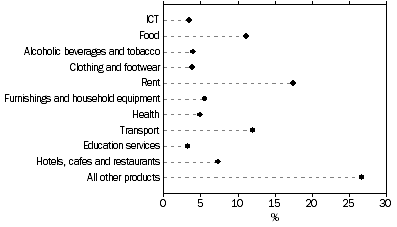
INTERNATIONAL TRADE IN ICT
Australia experienced a deficit of $9.7 billion in net trade in ICT products in 2002-03. That is, the level of ICT product imports ($14.0 billion) was $9.7 billion greater than ICT product exports ($4.2 billion). ICT imports accounted for 8.4% of all imports while ICT exports accounted for 2.8% of exports. Re-exports made up $1.2 billion of total ICT imports and exports. Re-exports are imports which are exported in the same condition or after undergoing only minor transformation which leaves them essentially unchanged. Computer hardware and telecommunication equipment together made up 73.5% of ICT imports. The largest ICT export items were computer hardware at $1.3 billion and telecommunication services at $1.1 billion. In combination, these two items comprised 55.2% of total ICT exports in 2002-03.
ICT EMPLOYMENT
For analytical purposes ICT employment is defined to include 'computing professionals and technicians' working in both ICT and non-ICT related industries. ICT employment excludes persons employed in ICT related industries in such activities as data entry, call centre and general management and administration.
Computing professionals and technicians accounted for 2.5% (or 234,700 persons) of total employed persons in 2002-03. Computing professionals dominated this category, accounting for 74% or 174,800 persons. 'Computing professionals' covers system managers, designers, programmers and auditors, software designers, and applications and analyst programmers.
The Property and business services industry employed 49.1% of all computing professionals and technicians in 2002-03. The second largest industry employer of computing professionals and technicians was Government administration and defence (9.0% or 21,100 persons) followed by Finance and insurance (8.1% or 19,100 persons).
Employed persons, Computing professionals and technicians - By industry - 2002-03
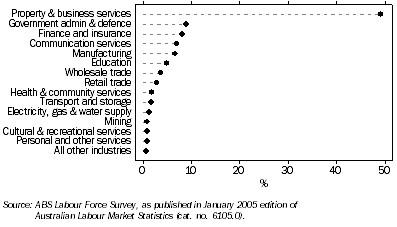
 Print Page
Print Page
 Print All
Print All